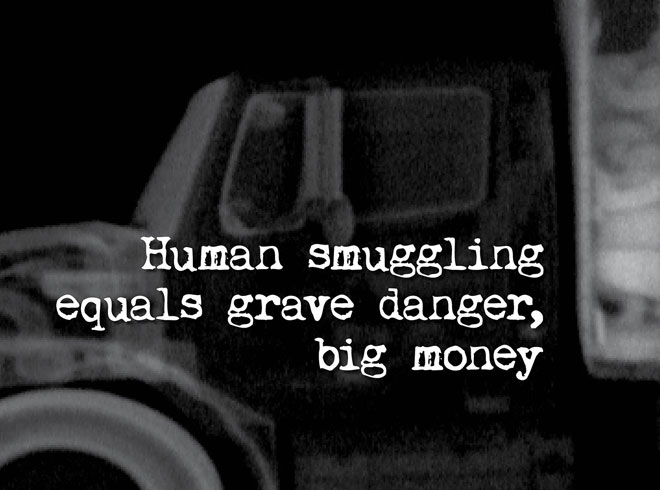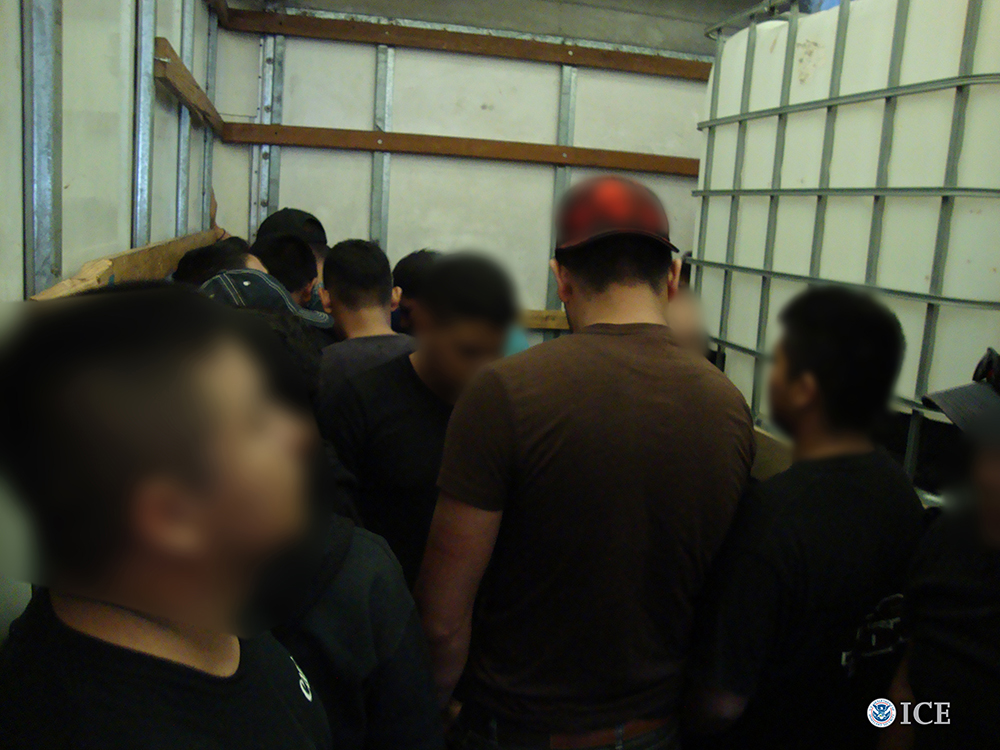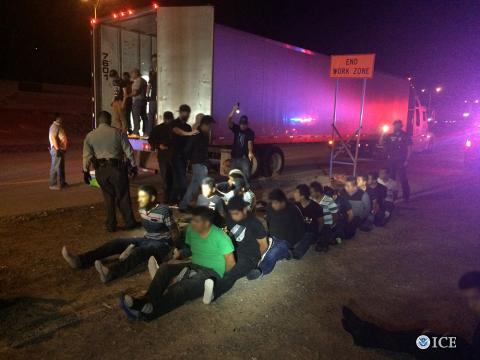
By U.S. Immigration and Customs Enforcement (ICE)
Moving human beings as cargo pays in the billions of dollars for transnational criminal smuggling organizations.
Human smuggling is the illegal importation of people into a country via the deliberate evasion of immigration laws.
U.S. Immigration and Customs Enforcement (ICE) serves as the leading U.S. law enforcement agency responsible for the fight against human smuggling.
“They have no concern for humanity, none; it’s a money business,” said Jack Staton, acting special agent in charge for ICE Homeland Security Investigations El Paso, Texas, “they look at people as merchandise, as a way to make money.”
Staton most often encounters individuals crossing from the Juárez, Mexico area, into Texas and New Mexico.

smugglers after entering the U.S. (Image courtesy of ICE)
Individuals seeking covert entry into the United States know they need to pay an organization for transport.
Smuggling organizations, often associated with other transnational criminal organizations and able to take advantage of people in desperate circumstances, provide that transportation at a significant cost.
Human smuggling on the southwest border of the U.S. is a daily occurrence.
“The Rio Grande Valley is the busiest area for human smuggling activity in the U.S. right now,” said Staton, “from San Diego, California, to Brownsville, Texas, there is activity every day.”
Smugglers escort the illegal aliens through the desert, across the border, to stash houses and onto their final destinations within the interior of the U.S.
A portion of the smuggling fees paid to the transnational criminal organizations helps fuel their other criminal enterprises.

transported by smugglers after crossing the border. (Image courtesy of ICE)
Endless ways exist in which to smuggle human beings and most of them don’t take into account personal safety or comfort.
Smugglers move humans as part of cargo transports, in vehicles, in boats, in tractor-trailers, in box cars on trains and in automobiles and trucks that are transported on trains as cargo.
Smugglers also utilize legitimate transportation options such as commercial buses and flights.
Illicit migrants traveling to the U.S. often pay additional fees for certain types of transportation methods; for example, an individual may pay extra money for transport in a tractor-trailer because the chance of making it across the border is greater than on foot.
If the trip takes place in the summer, temperatures can easily rise above 100 degrees in the truck and the situation can quickly become dangerous.
Underestimating the potential danger of human smuggling can have a deadly outcome.
As evidenced by recent events in San Antonio, Texas, higher smuggling fees paid to smuggling organizations do not guarantee safe transit.
The smugglers in that case had assured the illegal aliens that their tractor-trailer had refrigeration.
Ten people died in transit.1
(Acting ICE director Thomas Homan speaks out about the truck tragedy. Courtesy of Fox News and YouTube. Posted on Jul 24, 2017)
“No matter what a smuggler may say to an illegal alien, the minute the alien is smuggled, the smuggler can no longer control the circumstances,” said Staton.

not taken up by cargo. (Image courtesy of ICE)
The lack of control does not represent a crisis of conscience for those who run smuggling organizations.
While smugglers most often transport adult males, the number of women, children and family units seeking transport has increased dramatically in recent years.2 3
They often find themselves at risk for assault and abuse such as rape, beatings, kidnapping and robbery. Smugglers regularly overcrowd living and sleeping accommodations, and withhold food and water.
In addition, individuals who are smuggled may be forced into human trafficking situations upon their arrival in the U.S. or their families may be extorted.
Even knowing these dangers, the majority of people who travel with a smuggling organization do so voluntarily.
The responsibility of enforcing immigration laws belongs to ICE.

the southwest border. (Image courtesy of ICE)
“It is our job to identify illegal aliens, put them in removal proceedings and deport them to their home countries,” said Staton.”
“For people to spend money and put themselves in harm’s way is an exercise in futility; once they get to the U.S., we are going to find them and remove them.”
“It’s a priority for us to identify and prosecute the human smugglers who subvert our laws and put people’s lives in danger.”
“It is also our priority to seize transnational criminal organization’s ill-gotten funds and assets, which are the life blood of these criminal enterprises.”
The responsibility of enforcing immigration laws belongs to ICE.
“Rest assured, ICE Homeland Security Investigations will stop at nothing to carry out our work in order to protect the homeland.”
1 NPR, Truck Driver Charged with Human Smuggling after 10 Die in Stifling Conditions, July 24, 2017, www.npr.org
2 Pew Research Center, U.S. border apprehensions of families and unaccompanied children jump dramatically, May 4, 2016, www.pewresearch.org
3 U.S. Customs and Border Protection, Statistics and Summaries, BP Southwest Border Family Units and UAC Apps, FY 2017 vs. FY 2016, www.cbp.gov
4 U.S. Department of Justice, FY 2016 Statistics Yearbook, www.justice.gov/EOIR
















